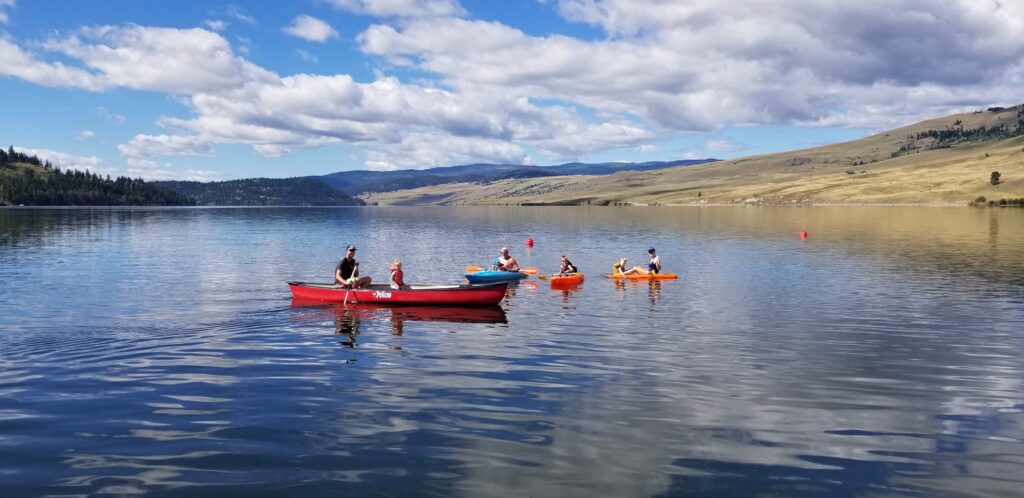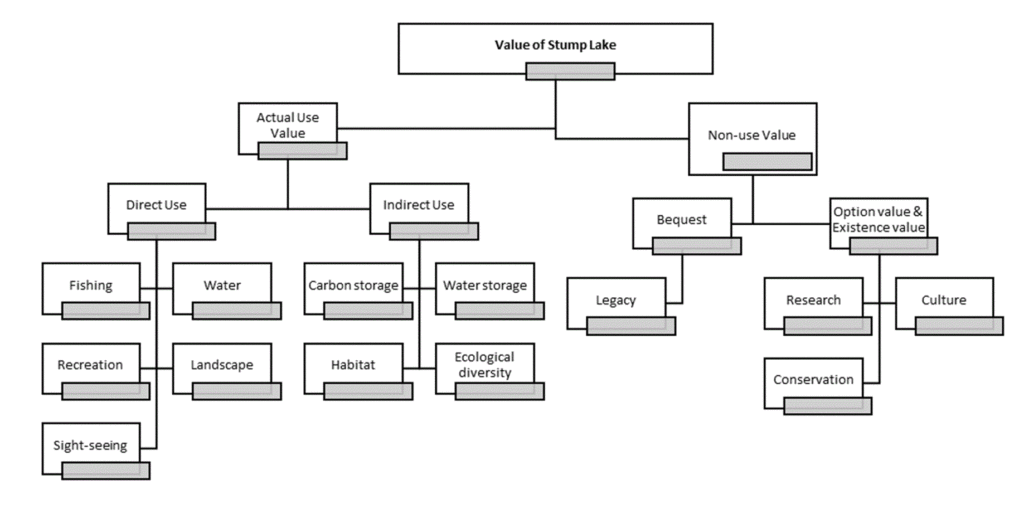8 Stump Lake
Nripesh Kunwar
About Stump Lake
Situated along the old Princeton Kamloops Highway (Highway 5A), Stump Lake lies 40 km south of Kamloops and 40 km north of Merritt (Stump Lake Life, n.d.a). As shown in Figure 1, the lake is about 11 km long and surrounded by rolling hills in the Nicola Valley grasslands (BC Geographical Names, n.d.). The coordinates of Stump Lake are 50°22’59″ N and 120°20’04″ W. According to the inventory carried out by the Ministry of Environment, Lands, and Parks, the surface area of water is 708 ha, with a maximum depth of 6.9 m and a minimum depth of 2.2 m, and a shoreline perimeter of 2,218 m (Hoffman & Jantz, 1999).
According to belief, Stump Lake is a relatively recent lake that emerged in the late 1700s after a spruce swamp survived natural flooding (Stump Lake Life, n.d.a). The name “Stump Lake” originated from the dead stumps of spruce trees that became visible after the swamp became submerged in water (Balf, 1978). Stump Lake holds significance in the history of the Indigenous people as it served as one of the primary settlement locations for the alliance between the Okanagan and Nlaka’pamux tribes, later known as the Nicola people.

Recreational Activities
Stump Lake was once known for its huge trout fish of 15 lb (British Columbia Adventure Network, n.d.c). The lake is home to rainbow trout, Brook Trout, and Kokanee. Some fish species, like Kokanee and rainbow trout, have been released into the lake to test survival (Kamloops This Week, 2006). The lake still produces large amounts of fish. Spring and fall are the best fishing seasons (British Columbia Adventure Network, n.d.c). Out of 110 lakes in British Columbia that harbour Kokanee Salmon fish, Stump Lake was placed among the Top 10 most productive sites for Kokanee (Fougere, 2022). The main reasons for this productivity were the nutrient-rich water and lower angler pressures. It also provides an opportunity for angling.
Stump was once known for Force Ten Summer Class, a major sailing event. Activities like windsurfing and ice fishing were conducted there (Atkinson et al., 1999). Experts reported that Stump Lake has 20 species of waterfowl, as many as 5000 birds some days, and many grass species such as Tullee, Napier, Richie, Trap, and Shumway.
Fun Fact — Stump Lake was a filming location for a few films and advertisements, including for Toyota, Hummer, Ford, and Harley Davidson (Chrome Catchers, n.d.b).
The scenic beauty of the lake is wonderful because grasslands surround it (Stump Lake Life, n.d.b). Because the lake is home to many game fish, fishing is a major attraction for visitors. Boating is also preferable when the day is not windy. Boating was once banned in Stump Lake as the water rose to a dangerous level (Kamloops This Week, 2017). The ban was lifted once the water level was normal, with caution regarding the speed limit and a towing policy.
Ecosystem Services
The materials, energy, and information from the lake ecosystem, in addition to human and physical capital, can bring about human welfare; however, when these lakes are very remote, they are unlikely to be in human interest (Costanza et al., 1997). Using ecosystem services found by Costanza et al. (1997), some of the more prominent ecosystem services and goods provided by Stump Lake have been listed in Table 1.
Table 1: Stump Lake Ecosystem Services
| Skip Table 1 | ||
| Ecosystem Service | Function | Examples |
|---|---|---|
| Climate Regulation | Regulation of local temperature, precipitation, and other biologically mediated climatic processes | Greenhouse gas regulation, Cloud formation |
| Water Regulation | Regulation of hydrological flows | Water cycle, Retention of water, Aquifers |
| Nutrient Cycling | Nutrient storage, internal cycling, processing, and acquisition | Nitrogen fixation, Other elemental cycling (e.g., phosphorus) |
| Biological Control | Trophic-dynamic regulation of populations | Habitat for aquatic species (e.g., fish) |
| Genetic Resources | Source of unique biological material and products | Products for science, Genes for resistance, Ornamental species |
| Recreation | Opportunities for recreational activities | Ecotourism, Sport fishing, Boating, Sight-seeing |
| Cultural | Opportunities for non-commerical uses | Aesthetics, Education, Research |
| Food Production | Primary production of something extractable as food | Fish, Game crops, Nuts, Subsistence farming or fishing |
| Refugia | Habitat for resident and transient population | Habitat for locally harvested species |
Note. Adapted from Costanza et al. (1997).
There is no denying the existence of other ecosystem services (e.g., waste treatment and raw materials) not included in Table 1; however, these services seem less significant in the context of Stump Lake. Possible reasons for this insignificance can be the lake not having an outlet for water to leave the lake as well as increasingly severe and harsh environments (e.g., droughts, high pH values, and high mineral concentrations) (Kamloops This Week, 2006). The total economic value is the sum of the use and non-use values. Pearce (1987) defined total economic value as the sum of three distinct categories: actual use value, option value, and existence value (Thomas et al., 1991).
Figure 2 shows a breakdown of the ecosystem services and economic applications that can be extracted from Stump Lake.

Valuation of Stump Lake
Methodology
Freshwater lakes have tremendous ecosystem services to human beings, including market goods (e.g., water) and non-market goods and services (e.g., biodiversity) (Schallenberg et al., 2013). However, all of the services provided by freshwater bodies are not easily observable, often difficult to monetize, and not given adequate weightage in policy formulation (Costanza et al., 1997; Schallenberg et al., 2013). Meanwhile, there has been a significant body of works by natural scientists such as Costanza et al. (1997), Daily (1997), and Pimental et al. (1997), helping us understand the value of invaluable services provided by ecosystem functions (Pimentel, 1998).
The benefit transfer method (BTM) has been used to estimate the value of ecosystem services provided by Stump Lake. The BTM involves using information on the economic value of ecosystem services from a similar ecosystem and applying it to the target site, in this case, Stump Lake. Plummer (2009) defines the benefit transfer method as a technique for estimating the total economic value of a site. The benefit transfer method is advantageous because it allows for using previously collected data on the estimated value of other ecosystems, which is readily available and cost-effective when working with limited resources.
Results & Discussion
Table 2 presents the value of ecosystem services per year and the value of the Stump Lake. It is not easy to put dollar value to natural goods and services. However, measuring their values is essential to use them wisely and properly and to protect the lake from overexploitation. When considering the history, area, and varied ecosystem services that Stump Lake provides, the value of resources in a conservative way was found to be approximately USD 17 million per year. The ecosystem services keep on rendering its services continuously. The Table also shows the value of Stump Lake. Using a 1.5% discount rate, the conservative estimate of the value of the lake is $1.1 billion; meanwhile, a 0.1% rate that places importance on the long term, including Indigenous usage, yields a value of USD 17 billion.
Table 2: Value of Stump Lake as a Natural Asset
| Skip Table 2 | |||
| Value Type | Ecosystem services per year (710 ha) | 1.5% Discount Rate (in millions, USD) | 0.1% Discount Rate (in billions, USD) |
|---|---|---|---|
| Average | 55,950,840 | 3,730 | 56 |
| Median | 40,985,360 | 2,732 | 41 |
| Modified Median | 16,714,820 | 1,114 | 16.7 |
Concluding Remarks
Stump Lake is an important and beautiful place for Kamloops and British Columbia due to its location, size, and many different ecological services it provides. Although the lake provides an opportunity for fishing and boating, there is a fairly low turnout of visitors due to a lack of information and no promotional events. The valuation method employed here makes a rational inference about the value of Stump Lake based on previous studies of similar ecological sites. Using the travel cost or hedonic price method would give us more accurate and reliable information than the lake actually renders. We hope that after revealing valuable information and insights about the lake, the value of the lake will be appreciated, and proper initiatives will be taken in general to sustain ecosystem services and the lives that rely on them.
Media Attributions
Figure 1: “0200809-104923-Original” by Eric Ens (2020), via Wikimedia Commons, is used under a CC BY-SA 4.0 license.
Figure 2: “Value of Stump Lake ecosystem services” by the author is under a CC BY-NC-SA 4.0 license.
References
Atkinson, L., Coull, C., Leighton, D., Lutz, J., Obee, B., Mayhew, A., McGill, B., Neering, R., Schaefer, J., Scott, A., & Stirling, J. (1999). The Big New BC Travel Guide. Beautiful British Columbia.
BC Geographical Names. (n.d.). Stump Lake. Government of British Columbia. https://apps.gov.bc.ca/pub/bcgnws/names/8751.html
British Columbia Adventure Network. (n.d.c). Stump Lake. http://www.bcadventure.com/adventure/explore/high_country/lac_la_jeune/stump.htm
Chrome Catchers. (n.d.b). Explore Stump Lake. https://www.chromecatchers.com/stump-lake
Costanza, R., d’Arge, R., de Groot, R., Farber, S., Grasso, M., Hannon, B., Limburg, K., Naeem, S., O’Neill, R. V., Paruelo, J., Raskin, R. G., Sutton, P., & van den Belt, M. (1997). The value of the world’s ecosystem services and natural capital. Nature, 387(15), 253–260. https://doi.org/10.1038/387253a0
Daily, G. C. (Ed.). (1997). Nature’s services: Social dependence on natural ecosystems. Island Press.
Ens, E. (2020). 0200809-104923-Original [Image]. Wikimedia Commons. https://commons.wikimedia.org/wiki/File:20200809-104923-Original.jpg
Fougere, B. (2022, May 19). Top 10 Kokanee lakes in BC. BC Outdoors. https://www.bcoutdoorsmagazine.com/top-10-kokanee-lakes-in-bc/
Hoffman, K., & Jantz, B. (1999). Reconnaissance lake inventory of Stump Lake. Ministry of Environment, Lands and Parks Southern Interior Region. https://a100.gov.bc.ca/pub/acat/documents/r117/stump_lake_1057274155701_fef134b1d2284473a62cfe0d35b0dad6.pdf
Kamloops This Week. (2006, May 26). Stocking Stump for sport. https://archive.kamloopsthisweek.com/2006/05/26/stocking-stump-for-sport/
Kamloops This Week. (2017, May 26). Boating bans lifted at Stump, Nicola lakes. https://archive.kamloopsthisweek.com/2017/05/26/boating-bans-lifted-at-stump-nicola-lakes/
Pearce, D. W. (1987). Economics values and the natural environment. University College London, Department of Economics.
Pimentel, D. (1998). Economic benefits of natural biota. Ecological Economics, 25(1), 45–47. https://doi.org/10.1016/S0921-8009(98)00014-7
Pimentel, D., Wilson, C., McCullum, C., Huang, R., Dwen, P., Flack, J., Tran, Q., Saltman, T., & Cliff, B. (1997). Economic and environmental benefits of biodiversity. BioScience, 47(11). 747–757. https://doi.org/10.2307/1313097
Plummer, M. L. (2009). Assessing benefit transfer for the valuation of ecosystem services. Frontiers in Ecology and the Environment, 7(1), 38–45. https://doi.org/10.1890/080091
Schallenberg, M., Winton, M., Verburg, P., Kelly, D., Hamill, K. D., & Hamilton, D. P. (2013). Ecosystem services of lakes. In J. R. Dymond (Ed.), Ecosystem services in New Zealand: Conditions and trends. Manaaki Whenua Press. https://doi.org/10.7931/DL1MS3
Stump Lake Life. (n.d.a). About Stump Lake. https://stumplakelife.ca/about
Stump Lake Life. (n.d.b). Home. https://stumplakelife.ca/
Thomas, D. H. L., Ayache, F., & Hollis, G. E. (1991). Use and non-use values in the conservation of Ichkeul National Park, Tunisia. Environmental Conservation, 18(2), 119–130. https://doi.org/10.1017/S037689290002169X
Long Descriptions
Figure 2 Long Description: A tree diagram that breaks down the value of Stump Lake. Starting at the top, the Value of Stump Lake is broken down into Actual Use Value and Non-Use Value. Actual Use Value is further divided into Direct Use and Indirect Use. For Direct Use, examples include fishing, water, recreation, landscape, and sight-seeing. For Indirect Use, examples include carbon storage, water storage, habitat, and ecological diversity. Back to Non-Use Value, it is further divided into Bequest and Option Value/Existence Value. Bequest includes legacy, while Option Value/Existence Value includes research, culture, and conservation. [Return to Figure 2]

